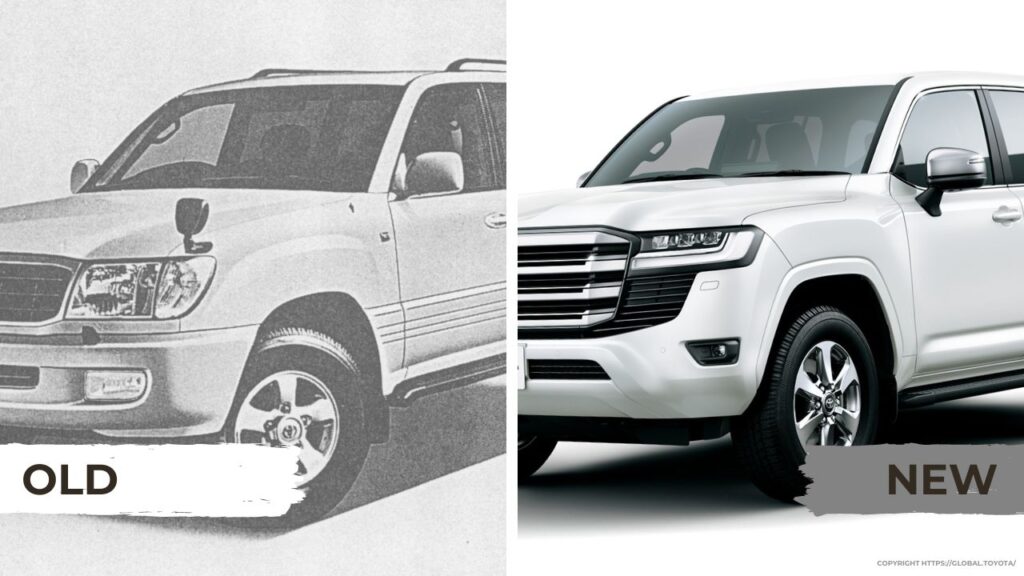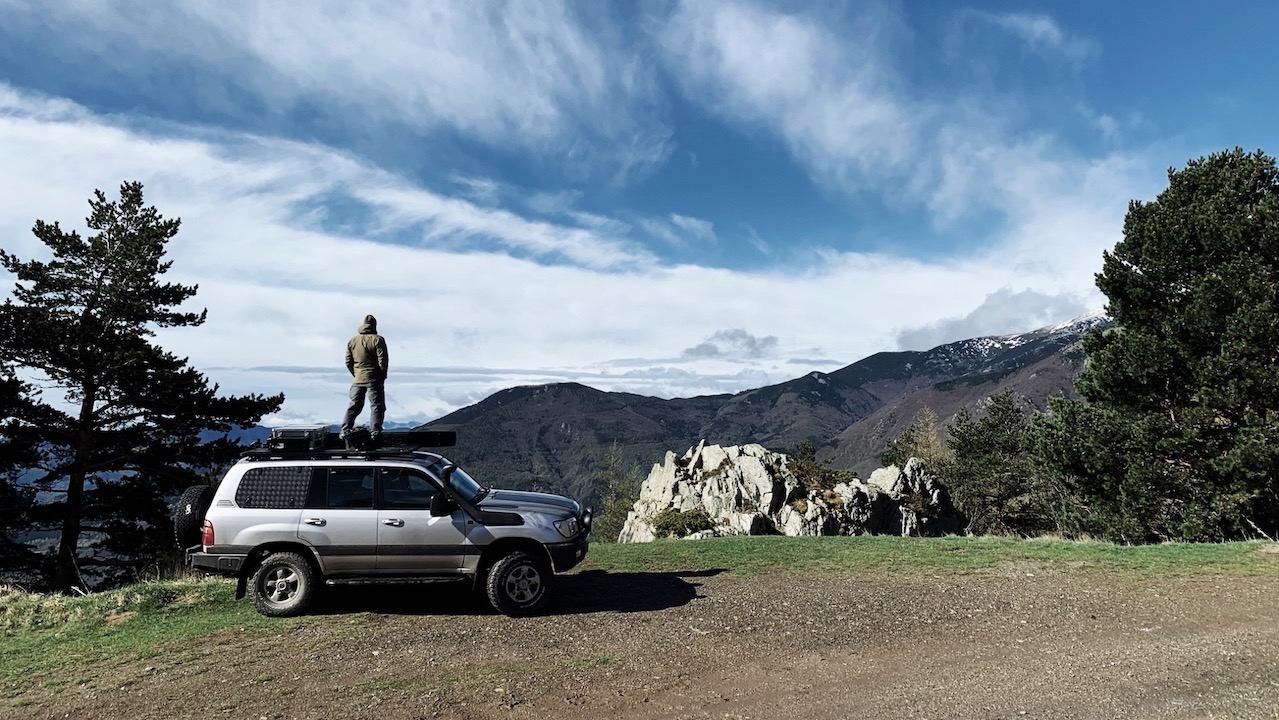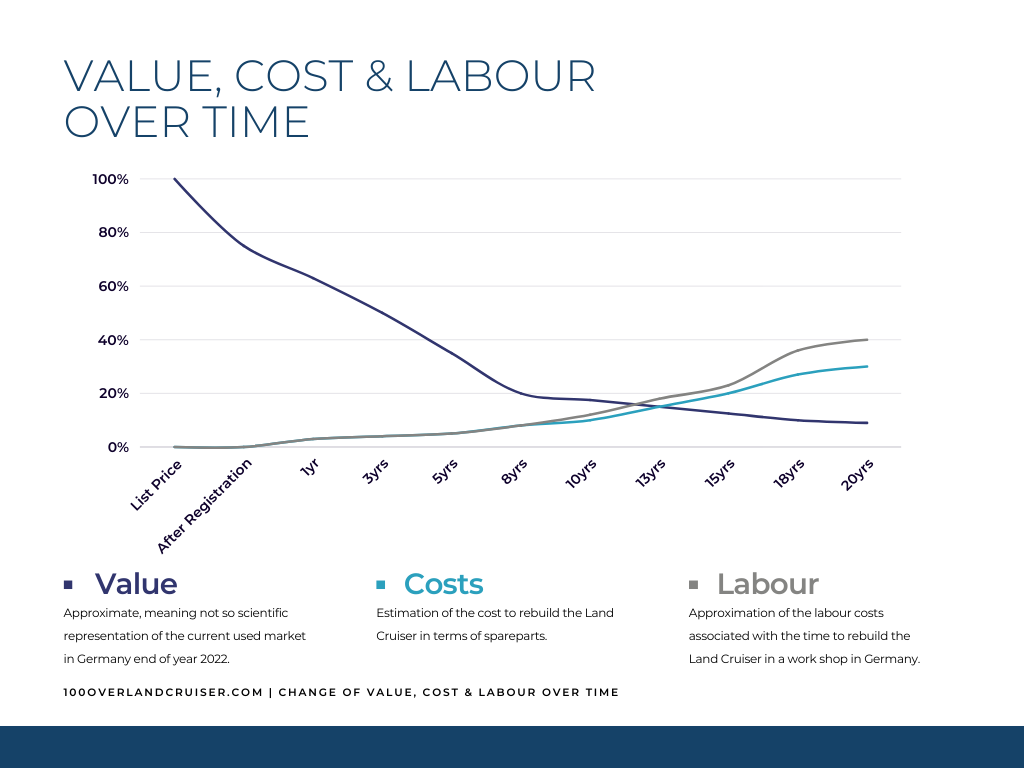Stay tuned for a breakdown of the new or old LandCruiser decision, where we navigate the complexities of performance, customization, and overall overland readiness.

- I. Introduction
- II. Exploring the New or Old LandCruiser Dynamics
- III. The Appeal of a New Land Cruiser
- Navigating the High Upfront Cost
- Value Fluctuations: The Impact of Modifications
- Risk Mitigation: Minimizing Unforeseen Repair Costs
- Immediate Exploration vs. Intimate Vehicle Knowledge
- Cost of Upkeep: Balancing Efficiency and Expenses
- Insurance Dynamics: Understanding the Higher Costs
- Trail Damage Realities: Navigating Higher Costs
- After-Market Challenges: Initial Limitations
- IV. The Allure of an Older Land Cruiser
- Lowest Upfront Costs: A Financial Advantage
- Value Potential: A Double-Edged Sword
- Risk Considerations: Navigating the „Shitbox“ Dilemma
- Time Investment: From Learning Curve to Reliability
- Cost of Upkeep: Balancing Maintenance, Fuel Consumption, and Repairs
- Insurance Dynamics: Lower Premiums, Higher Value
- After-Market Riches: A World of Possibilities
- Pro-Tip When Buying a Used Land Cruiser
- V. Side By Side Comparison Of New Or Old LandCruisers
- VI. Discussion
- VII. Conclusion
I. Introduction
The debate over new vs old LandCruiser in the car industry goes beyond simple financial reasons. It’s a delicate compromise between financial capability and the willingness to invest time. A variety of considerations must be evaluated while deciding between a new model, an expression of financial capabilities, and the prospect of devoting time to rebuild an older model.
The attractiveness of the Toyota Land Cruiser, an iconic choice in this argument, lies beyond the conflict of money against time. It’s a vehicle that represents more than just transportation; it represents the spirit of adventure and endurance. In this analysis, we look into the difficulties of the new vs old paradigm in the automotive sector.
II. Exploring the New or Old LandCruiser Dynamics
As we continue the comparison between new and old LandCruisers, our focus sharpens on critical aspects shaping the decision-making process.
Initial Cost Consideration
Examining the initial investment lays the foundation for our deliberation. It’s not just about numbers; it’s about setting the financial groundwork for our overland journey.
Change in Value Over Time
Understanding the evolving value dynamics provides insight into the long-term implications of our choice. It’s a strategic consideration for the journey ahead.
Risk Assessment for Repairs
Navigating the realm of repairs requires a risk assessment. We weigh the potential challenges, acknowledging the pivotal role repair considerations play in our decision.
Travel Readiness Evaluation
Assessing travel readiness is more than a checklist; it’s about ensuring our chosen LandCruiser aligns seamlessly with the demands of our overland adventures.
Learning Curve: Getting to Know Your Vehicle
Delving into the nuances of the learning curve, we embrace the journey of getting acquainted with our chosen vehicle. It’s a crucial phase that shapes our overland experience.
Cost of Upkeep: Beyond the Initial Investment
Our exploration extends to the ongoing costs—insurance, maintenance, and aftermarket parts. It’s a holistic evaluation that goes beyond the surface, aligning with our commitment to a comprehensive analysis.
Adhering to these guidelines, we immerse ourselves in a meticulous examination of the new or old LandCruiser comparison, addressing key facets that influence our overland decision-making process.
III. The Appeal of a New Land Cruiser
As we embark on the quest for the ideal overland companion, delving into the new versus old Land Cruiser debate—a voyage plagued with financial complexities and technological appeal. Our investigation into new Land Cruisers begins with the high upfront cost. Which provides a blank and fully functional canvas for customisation. However, this attractiveness is accompanied with the value deprication associated with new cars, modifications, immediate exploration, and greater insurance prices all intertwine.
Navigating the High Upfront Cost
In delving into the realm of a new Land Cruiser, the journey begins with a notable financial commitment—a high upfront cost that often deters potential buyers. However, this investment lays the groundwork for an overland experience backed by cutting-edge technology, advanced safety features, and the assurance of a pristine, untouched vehicle.
And, given the rising pricing and ideological value of used Land Crusiers these days, getting a new one might actually be a sensible choice.
Value Fluctuations: The Impact of Modifications
The attractiveness of customisation compels, but it comes at a cost. While modifications and build-outs improve the Land Cruiser’s capabilities, they also result in a significant loss of value. Each extra feature should be balanced against its impact on the vehicle’s potential resale value, underlining the financial factors inherent in the decision-making process for a new or used Land Cruiser.
Risk Mitigation: Minimizing Unforeseen Repair Costs
Opting for a new Land Cruiser grants us the advantage of a warranty, significantly mitigating the risk of unforeseen repair costs during the initial years. This warranty coverage provides peace of mind, aligning with our pursuit of a reliable and hassle-free overland experience.
The risk can be further reduced by purchasing a model amidst the product’s life-cycle, after the first issues have been fixed or after-market solutions are available.
Immediate Exploration vs. Intimate Vehicle Knowledge
The appeal of a new Land Cruiser lies in the immediacy it offers. With almost no initial repairs and very few modifications required, we can embark on our overland journey promptly. However, this immediacy comes at the cost of not intimately knowing our vehicle from the start—a trade-off that underscores the new or old Land Cruiser dilemma.
Cost of Upkeep: Balancing Efficiency and Expenses
While the initial cost may be high, the cost of upkeep for a new Land Cruiser tends to be lower. Improved fuel efficiency contributes to reduced expenses over the vehicle’s lifespan. Additionally, lower inspection costs further enhance the overall economic appeal, adding layers to our understanding of the new or old Land Cruiser dynamics.
Insurance Dynamics: Understanding the Higher Costs
Higher insurance costs accompany the acquisition of a new Land Cruiser. The intricate technology, safety features, and potential repair costs contribute to this higher insurance premium. Recognizing and understanding these dynamics is integral to our comprehensive evaluation within the new or old Land Cruiser landscape.
Trail Damage Realities: Navigating Higher Costs
As we navigate the rugged terrains of overlanding, the new Land Cruiser’s complexity translates to higher trail damage costs. The intricacies of modern vehicles often result in more intricate repairs, with multiple parts potentially needing replacement at higher costs—a reality that factors prominently into our deliberations within the new or old Land Cruiser decision-making process.
After-Market Challenges: Initial Limitations
Exploring the after-market for a new Land Cruiser reveals initial limitations. The availability of parts may be scarce, restricting our options for customization and modifications. This underscores the importance of strategic planning and consideration in navigating the landscape of the new or old Land Cruiser topic.
This again, can be mitigated by purchasing a model amidst the product’s life-cycle.
As we near the end of our investigation into the attractiveness of an older Land Cruiser inside the new or old LandCruiser tale, we find ourselves at a crossroads of cost-conscious judgments and the breadth of customization options. The path chosen becomes a distinguishing component of our overland journey, whether motivated by financial prudence or an itch for a timeless relationship.
IV. The Allure of an Older Land Cruiser
In the intricate dance between the new or old LandCruiser discussion, the temptation of choosing an older Land Cruiser beckons. It’s a journey marked by financial astuteness, risk considerations, and the captivating prospect of transforming a seasoned vehicle into a valued overland companion.
HERE is an in depth view at an older model Land Cruiser as an example.

Lowest Upfront Costs: A Financial Advantage
Choosing an older Land Cruiser opens the door to a financial advantage marked by the lowest upfront costs. This initial investment advantage provides us with flexibility, allowing for potential reallocation of funds towards modifications, enhancements, or other aspects of our overland journey.
Value Potential: A Double-Edged Sword
The allure of an older Land Cruiser extends beyond cost considerations. There’s a significant chance of increasing its value through proper repairs and restoration efforts. However, this prospect is balanced delicately against the actual costs of repairs—a dynamic interplay that forms a crucial aspect of the new or old LandCruiser decision-making process.
Risk Considerations: Navigating the „Shitbox“ Dilemma
Opting for an older Land Cruiser introduces an element of risk—the potential acquisition of a „shitbox.“ This colloquial term encapsulates the challenge of encountering a vehicle that demands a continuous string of follow-up repairs. Navigating this risk becomes a critical aspect of the new or old LandCruiser exploration.
Time Investment: From Learning Curve to Reliability
Investing in an older Land Cruiser is not just a financial commitment but a significant allocation of time. The vehicle might not be travel-ready from the start, and its reliability may be in question. The allure lies in the steep learning curve—a journey that allows us to intimately know our vehicle, fostering a deep connection within the new or old LandCruiser landscape.
Cost of Upkeep: Balancing Maintenance, Fuel Consumption, and Repairs
While the upfront costs are enticingly low, the older Land Cruiser path comes with a higher cost of upkeep. Increased maintenance costs, higher fuel consumption, and the potential for ongoing repairs contribute to this dynamic. Balancing these considerations becomes pivotal within the management of the new or old LandCruiser topic.
Insurance Dynamics: Lower Premiums, Higher Value
Choosing an older Land Cruiser leads to lower insurance premiums—a financial advantage in the ongoing journey. Despite potential risks, the allure lies in the financial benefits and the higher perceived value achievable through proper maintenance. This aspect becomes a cornerstone in our exploration of the allure of an older Land Cruiser within the new or old LandCruiser narrative.
After-Market Riches: A World of Possibilities
Exploring the after-market parts arena for older Land Cruisers reveals a rich landscape of possibilities. Availability is at its peak, offering a vast array of options for customization and modifications. This abundance becomes a catalyst for personalization, opening a world of possibilities within the new or old LandCruiser discussion.
As we conclude our exploration into the allure of an older Land Cruiser within the new or old LandCruiser narrative, we find ourselves at the crossroads of cost-conscious decisions and the richness of customization possibilities. Whether driven by financial prudence or the desire for a timeless connection, the path chosen becomes a defining aspect of our overland journey.
Pro-Tip When Buying a Used Land Cruiser
Essential Manuals for Used Land Cruiser Rebuilding
When delving into the endeavor of rebuilding a used Land Cruiser, securing the original shop manuals for your specific model is paramount. These manuals serve as invaluable guides, providing intricate details essential for a meticulous restoration. If the original manuals prove elusive, opting for one of the available after-market books becomes a wise alternative. In our experience, having a comprehensive manual, like the one we always keep in our car, ensures that we are equipped with the necessary knowledge at all times. This proactive approach empowers us to tackle repairs, modifications, and maintenance with confidence, forming a cornerstone in the journey of revitalizing a used Land Cruiser.

Haynes Manual For Land Cruiser 100
- Valuable Instructions For Repairs
- Full Procedures Written From Hands-on Experience
V. Side By Side Comparison Of New Or Old LandCruisers
| Criteria | New Land Cruiser | Old Land Cruiser |
|---|---|---|
| Upfront Costs | Highest upfront investment with potential loss | Lowest initial investment |
| Value Dynamics | Significant loss due to deprication and modifications | Potential value increase with proper repairs |
| Risk of Repairs | Minimal risk due to warranty coverage and low mileage | Higher risk of unforeseen repairs and buying a shitbox |
| Travel Readiness | Immediate exploration, potential lack of familiarity | Time investment required, reliability considerations at the beginning |
| Learning Curve | Steeper, limited hands-on experience initially | Intensive learning curve, hands-on familiarity and confidence |
| Cost of Upkeep | Lower inspection and fuel costs, higher insurance | Higher maintenance costs, increased fuel consumption |
| Trail Damage Costs | Higher due to complex technology | Potential lower costs, simpler repair dynamics |
| After-Market Parts | Limited initially, expanding over time | Abundant availability, vast customization options |

VI. Discussion
While the above chart provides a pragmatic comparison between new and old LandCruisers, it’s crucial to emphasize its non-scientific nature. It serves as a visual aid, illustrating the correlation between cost, labor, and value in the decision-making process. Notably, it doesn’t encapsulate the intangible ideological value often associated with the Land Cruisers heritage, nor does it account for price fluctuations driven by market demand.
Take our Land Cruiser 100 as an illustration; its original retail price was 85,000€, but acquired for a mere 8-10k. We’ve invested around 20k in spare parts and 30-40k in labor costs, showcasing the extensive spectrum. This firsthand example provides insight into utilizing the chart as a guide. Stay tuned for our upcoming case study comparing the cost of a new 300 to a used 100 Series Land Cruiser, including valuable tips for purchasing a pre-owned Land Cruiser. Sign up for our newsletter to be notified of our latest blog posts.
VII. Conclusion
Certified Pre-Owned (CPO) Land Cruisers
For those seeking a middle ground between new and used, Certified Pre-Owned (CPO) Land Cruisers provide a compelling option. These vehicles undergo rigorous inspections, come with extended warranties, and offer a compromise between the cost savings of a used model and the peace of mind of a new one.
Building a Used Land Cruiser Wisely:
If you decide to go for a well-used Land Cruiser, strategic planning is key. Thoroughly inspect the vehicle’s maintenance history, assess its current condition, and budget for necessary repairs and upgrades. Prioritize essential modifications, such as a reliable suspension system and durable tires, to ensure the vehicle is well-prepared for overland adventures.
In the realm of overland travel, the choice between a new and used LandCruiser ultimately depends on individual preferences, budget considerations, and the willingness to invest time and effort into vehicle maintenance. Each option has its merits and drawbacks, and finding the right balance is crucial for a successful decision. Whether you opt for the latest technology and travel readiness or the charm of a well-used, but rebuilt Land Cruiser for a story to tell. The key is to embark on your overland adventure with a vehicle that aligns with your goals and enhances the overall experience.

